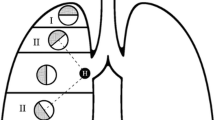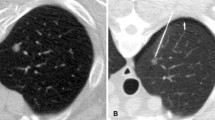Abstract
Objective
To assess whether pulmonary vein injury is detectable on CT and associated with air embolism after percutaneous transthoracic needle biopsy (PTNB) in a tertiary referral hospital.
Methods
Between January 2012 and November 2021, 11,691 consecutive CT-guided PTNBs in 10,685 patients were retrospectively evaluated. Air embolism was identified by reviewing radiologic reports. Pulmonary vein injury was defined as the presence of the pulmonary vein in the needle pathway or shooting range of the cutting needle with the presence of parenchymal hemorrhage. The association between pulmonary vein injury and air embolism was assessed using logistic regression analysis in matched patients with and without air embolism with a ratio of 1:4.
Results
A total of 27 cases of air embolism (median age, 67 years; range, 48–80 years; 24 men) were found with an incidence of 0.23% (27/11,691). Pulmonary vein injury during the procedures was identifiable on CT in 24 of 27 patients (88.9%), whereas it was 1.9% (2/108) for matched patients without air embolism The veins beyond the target lesion (70.8% [17/24]) were injured more frequently than the veins in the needle pathway before the target lesion (29.2% [7/24]). In univariable and multivariable analyses, pulmonary vein injury was associated with air embolism (odds ratio, 485.19; 95% confidence interval, 68.67–3428.19, p <.001).
Conclusion
Pulmonary vein injury was detected on CT and was associated with air embolism. Avoiding pulmonary vein injury with careful planning of the needle pathway on CT may reduce air embolism risk.
Key points
• Pulmonary vein injury during CT-guided biopsy was identifiable on CT in most of the patients (88.9% [24/27]).
• The veins beyond the target lesion (70.8% [17/24]) were injured more frequently than the veins in the needle pathway before the target lesion (29.2% [7/24]).
• Avoiding the distinguishable pulmonary vein along the pathway or shooting range of the needle on CT may reduce the air embolism risk.





Similar content being viewed by others
Abbreviations
- PTNB:
-
Percutaneous transthoracic needle biopsy
References
Hiraki T, Mimura H, Gobara H et al (2009) CT fluoroscopy-guided biopsy of 1,000 pulmonary lesions performed with 20-gauge coaxial cutting needles: diagnostic yield and risk factors for diagnostic failure. Chest 136:1612–1617
Lee KH, Lim KY, Suh YJ et al (2019) Diagnostic accuracy of percutaneous transthoracic needle lung biopsies: a multicenter study. Korean J Radiol 20:1300–1310
Cho J, Ko SJ, Kim SJ et al (2014) Surgical resection of nodular ground-glass opacities without percutaneous needle aspiration or biopsy. BMC Cancer 14:838
Heerink WJ, de Bock GH, de Jonge GJ, Groen HJ, Vliegenthart R, Oudkerk M (2017) Complication rates of CT-guided transthoracic lung biopsy: meta-analysis. Eur Radiol 27:138–148
Freund MC, Petersen J, Goder KC, Bunse T, Wiedermann F, Glodny B (2012) Systemic air embolism during percutaneous core needle biopsy of the lung: frequency and risk factors. BMC Pulm Med 12:2
Glodny B, Schönherr E, Freund MC et al (2017) Measures to prevent air embolism in transthoracic biopsy of the lung. AJR Am J Roentgenol 208:W184–w191
Ishii H, Hiraki T, Gobara H et al (2014) Risk factors for systemic air embolism as a complication of percutaneous CT-guided lung biopsy: multicenter case-control study. Cardiovasc Intervent Radiol 37:1312–1320
Cheng HM, Chiang KH, Chang PY et al (2010) Coronary artery air embolism: a potentially fatal complication of CT-guided percutaneous lung biopsy. Br J Radiol 83:e83–e85
Kodama F, Ogawa T, Hashimoto M, Tanabe Y, Suto Y, Kato T (1999) Fatal air embolism as a complication of CT-guided needle biopsy of the lung. J Comput Assist Tomogr 23:949–951
Hiraki T, Fujiwara H, Sakurai J et al (2007) Nonfatal systemic air embolism complicating percutaneous CT-guided transthoracic needle biopsy: four cases from a single institution. Chest 132:684–690
Richardson CM, Pointon KS, Manhire AR, Macfarlane JT (2002) Percutaneous lung biopsies: a survey of UK practice based on 5444 biopsies. Br J Radiol 75:731–735
Tomiyama N, Yasuhara Y, Nakajima Y et al (2006) CT-guided needle biopsy of lung lesions: a survey of severe complication based on 9783 biopsies in Japan. Eur J Radiol 59:60–64
Franke M, Reinhardt HC, von Bergwelt-Baildon M, Bangard C (2014) Massive air embolism after lung biopsy. Circulation 129:1046–1047
Ghafoori M, Varedi P (2008) Systemic air embolism after percutaneous transthorasic needle biopsy of the lung. Emerg Radiol 15:353–356
Mokhlesi B, Ansaarie I, Bader M, Tareen M, Boatman J (2002) Coronary artery air embolism complicating a CT-guided transthoracic needle biopsy of the lung. Chest 121:993–996
Park R, Lee SM, Kim S et al (2022) Learning curve for CT-guided percutaneous transthoracic needle biopsy: retrospective evaluation among 17 thoracic imaging fellows at a tertiary referral hospital. AJR Am J Roentgenol 218:112–123
Jeon SB, Lee HB, Koo YS et al (2020) Neurological emergencies in patients hospitalized with nonneurological illness. J Patient Saf. https://doi.org/10.1097/pts.0000000000000682
Muth CM, Shank ES (2000) Gas embolism. N Engl J Med 342:476–482
West JB, Dollery CT, Naimark A (1964) Distribution of blood flow in isolated lung; relation to vascular and alveolar pressures. J Appl Physiol 19:713–724
Kuramoto K, Rodbard S (1962) Effects of blood flow and left atrial pressure on pulmonary venous resistance. Circ Res 11:240–246
Alifano M, Forti Parri SN, Bonfanti B et al (2007) Atmospheric pressure influences the risk of pneumothorax: beware of the storm! Chest 131:1877–1882
LoMauro A, Aliverti A (2018) Sex differences in respiratory function. Breathe (Sheff) 14:131–140
Lee JH, Yoon SH, Hong H, Rho JY, Goo JM (2021) Incidence, risk factors, and prognostic indicators of symptomatic air embolism after percutaneous transthoracic lung biopsy: a systematic review and pooled analysis. Eur Radiol 31:2022–2033
Funding
The authors state that this work has not received any funding.
Author information
Authors and Affiliations
Corresponding author
Ethics declarations
Guarantor
The scientific guarantor of this publication is Sang Min Lee.
Conflict of interest
The authors of this manuscript declare no relationships with any companies, whose products or services may be related to the subject matter of the article.
Statistics and biometry
Hwa Jung Kim (department of clinical epidemiology and biostatistics, Asan Medical Center) performed statistical analyses.
Informed consent
Written informed consent was waived by the Institutional Review Board.
Ethical approval
Institutional Review Board approval was obtained.
Study subjects or cohorts overlap
3261 percutaneous transthoracic needle biopsies (PTNBs) performed between January 2012 and August 2017 have been reported in a prior study that assessed the learning curve for PTNB (Park R et al, reference 17) which was substantially different work from this study.
Methodology
• retrospective
• case-control
• performed at one institution
Additional information
Publisher’s note
Springer Nature remains neutral with regard to jurisdictional claims in published maps and institutional affiliations.
Supplementary Information
ESM 1
(PDF 167 kb)
Rights and permissions
Springer Nature or its licensor holds exclusive rights to this article under a publishing agreement with the author(s) or other rightsholder(s); author self-archiving of the accepted manuscript version of this article is solely governed by the terms of such publishing agreement and applicable law.
About this article
Cite this article
Ahn, Y., Lee, S.M., Kim, H.J. et al. Air embolism in CT-guided transthoracic needle biopsy: emphasis on pulmonary vein injury. Eur Radiol 32, 6800–6811 (2022). https://doi.org/10.1007/s00330-022-09079-6
Received:
Revised:
Accepted:
Published:
Issue Date:
DOI: https://doi.org/10.1007/s00330-022-09079-6




